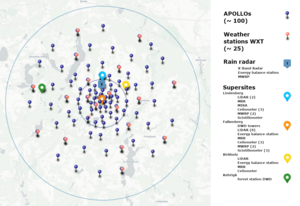Core Tasks

Measuring submesoscale variability and therefore developing a hierarchical measurement strategy were the core tasks of the field campaign FESSTVaL. During the summer months of 2021 it took place at the Meteorological Observatory Lindenberg – Richard-Aßmann-Observatory (MOL-RAO) of the German Weather Service (DWD) near Berlin, initiated by the Hans-Ertel-Center for Weather Research (HErZ). With respect to the source of submesoscale variability, the measurement campaign focused on three main aspects: boundary layer patterns, cold pools, and wind gusts.
Measurement Strategy
In order to capture phenomena at the submesoscale (500 m – 5 km), a hierarchical measurement strategy was realized. This includes wind profiling stations with a coordinated scanning strategy of several Doppler Lidars, two mobile profiler to measure thermodynamic properties and precipitation, more than 100 stations with near-surface measurements of air temperature and pressure, more than 20 automatic weather stations, an X-Band radar, and a number of energy balance stations. This equipment was supplemented by the extensive ground-based remote sensing array at the MOL-RAO, operated by DWD. Complementing to this, the added value of a citizen-science measurement network was investigated during the campaign with “Internet-of-things” based technology and low-cost sensors build and maintained by citizens. The measurements were complemented by high-resolution large-eddy simulations (ICON-LES) comprising the site.
A detailed map of the measurement sites is provided at uMap here.
Goals
The measurements conducted with this setup will be useful to (i) improve our process understanding, (ii) validate aspects of convection-permitting Numerical Weather Prediction (NWP) simulations and (iii) compare different measurement strategies and instrument types for the development of future measurement network designs.

